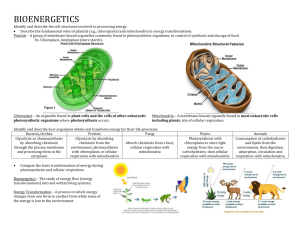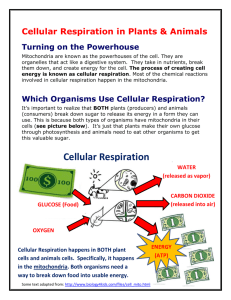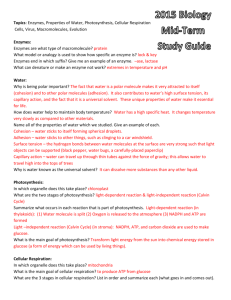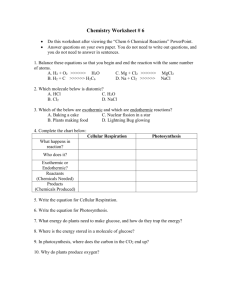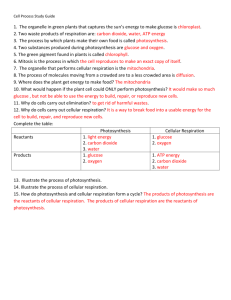91156-ass-2014
advertisement
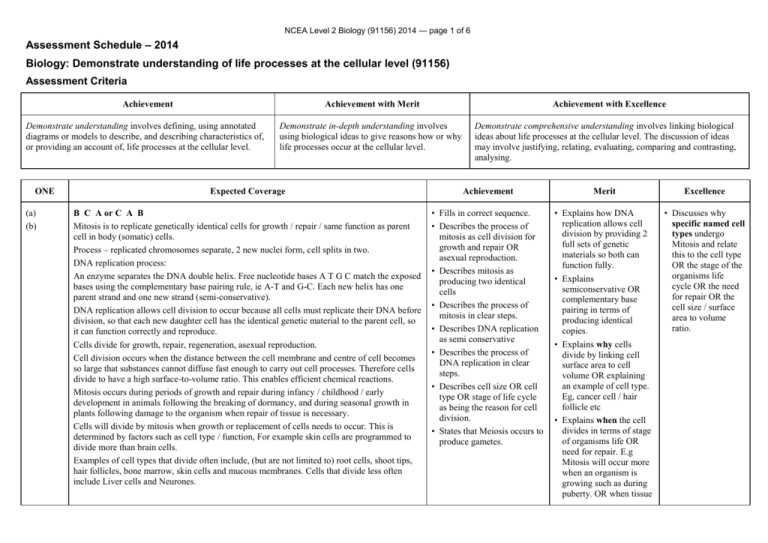
NCEA Level 2 Biology (91156) 2014 — page 1 of 6 Assessment Schedule – 2014 Biology: Demonstrate understanding of life processes at the cellular level (91156) Assessment Criteria Achievement Achievement with Merit Demonstrate understanding involves defining, using annotated diagrams or models to describe, and describing characteristics of, or providing an account of, life processes at the cellular level. ONE (a) (b) Achievement with Excellence Demonstrate in-depth understanding involves using biological ideas to give reasons how or why life processes occur at the cellular level. Demonstrate comprehensive understanding involves linking biological ideas about life processes at the cellular level. The discussion of ideas may involve justifying, relating, evaluating, comparing and contrasting, analysing. Expected Coverage Achievement Merit Excellence B C A or C A B Mitosis is to replicate genetically identical cells for growth / repair / same function as parent cell in body (somatic) cells. Process – replicated chromosomes separate, 2 new nuclei form, cell splits in two. DNA replication process: An enzyme separates the DNA double helix. Free nucleotide bases A T G C match the exposed bases using the complementary base pairing rule, ie A-T and G-C. Each new helix has one parent strand and one new strand (semi-conservative). DNA replication allows cell division to occur because all cells must replicate their DNA before division, so that each new daughter cell has the identical genetic material to the parent cell, so it can function correctly and reproduce. Cells divide for growth, repair, regeneration, asexual reproduction. Cell division occurs when the distance between the cell membrane and centre of cell becomes so large that substances cannot diffuse fast enough to carry out cell processes. Therefore cells divide to have a high surface-to-volume ratio. This enables efficient chemical reactions. Mitosis occurs during periods of growth and repair during infancy / childhood / early development in animals following the breaking of dormancy, and during seasonal growth in plants following damage to the organism when repair of tissue is necessary. Cells will divide by mitosis when growth or replacement of cells needs to occur. This is determined by factors such as cell type / function, For example skin cells are programmed to divide more than brain cells. Examples of cell types that divide often include, (but are not limited to) root cells, shoot tips, hair follicles, bone marrow, skin cells and mucous membranes. Cells that divide less often include Liver cells and Neurones. • Fills in correct sequence. • Describes the process of mitosis as cell division for growth and repair OR asexual reproduction. • Describes mitosis as producing two identical cells • Describes the process of mitosis in clear steps. • Describes DNA replication as semi conservative • Describes the process of DNA replication in clear steps. • Describes cell size OR cell type OR stage of life cycle as being the reason for cell division. • States that Meiosis occurs to produce gametes. • Explains how DNA replication allows cell division by providing 2 full sets of genetic materials so both can function fully. • Explains semiconservative OR complementary base pairing in terms of producing identical copies. • Explains why cells divide by linking cell surface area to cell volume OR explaining an example of cell type. Eg, cancer cell / hair follicle etc • Explains when the cell divides in terms of stage of organisms life OR need for repair. E.g Mitosis will occur more when an organism is growing such as during puberty. OR when tissue • Discusses why specific named cell types undergo Mitosis and relate this to the cell type OR the stage of the organisms life cycle OR the need for repair OR the cell size / surface area to volume ratio. NCEA Level 2 Biology (91156) 2014 — page 2 of 6 is damaged surrounding cells will divide to replace those lost / damaged. NØ No response; no relevant evidence. N1 Describes any ONE statement from Achievement. N2 Describes any TWO statements from Achievement. A3 Describes any THREE statements from Achievement. A4 Describes any FOUR statements from Achievement. M5 Explains any TWO statements from Merit. M6 Explains any THREE statements from Merit. E7 Discusses TWO FACTORS for Excellence. E8 Discusses THREE FACTORS for Excellence. NCEA Level 2 Biology (91156) 2014 — page 3 of 6 TWO Expected Coverage Photosynthesis occurs in plants / chloroplasts, and is a chemical reaction that splits water molecules into hydrogen and oxygen. Carbon dioxide is joined to the hydrogen to form glucose. The excess oxygen is released as by-product. The amount of water or CO available to the plant will affect the rate of photosynthesis. If the plant does not have enough water, the plant will be deprived of H or CO (so will be unable to construct a glucose molecule), and thus lower photosynthesis rate. Increased amount of CO will increase the rate of photosynthesis to a certain limit, after which a further increase in its amount will no longer increase the rate any further. This is when the other factors necessary for photosynthesis, such as light, become “limiting factors”; that is, those other factors also need to increase to bring about a further increase in the rate. The rate of photosynthesis will always correspond to the factor which is in least supply. Other factors that affect the rate are light intensity / availability / quality, wave length of light, amount of chlorophyll / chloroplast number, temperature, enzyme concentration, nutrients. Examples, but could discuss other factors: • Generally warmer temperatures are better than cooler temperatures for photosynthesis. This means enzymes can collide more with substrates and more chemical reactions can occur. However, if the temperature increases too much, the enzyme may denature, resulting in the active site changing shape (no longer fitting the substrate), in which case the chemical reactions would stop, and photosynthesis rate decrease / stop. • Different intensities of light provide different amounts of energy / photons. • Different wavelengths / colours of light provide different amounts of energy / photons. Least energy from Green light as it is reflected. • Plant nutrient exposure will affect the production of enzymes. As amino acids are required for enzyme construction / protein synthesis, if essential amino acids are not taken up by the plant, the plant may not be able to construct the enzymes necessary for photosynthesis to occur (thus decreasing the plants rate of photosynthesis). As well as this, the amount of nutrients, such as potassium and nitrates, also affects the rate of photosynthesis. These nutrients could be used by enzymes as co-factors. If the co-factors / nutrients are limited, this would limit chemical reactions and the rate of photosynthesis. 2 2 2 Achievement Merit Excellence • Writes a word / chemical equation with no mistakes. • Describes photosynthesis as plants using light energy to make chemical energy / sugar / glucose. • Water is split with Hydrogen joining with CO2 to produce sugar and O2 released as byproduct. • Describes that an increase / decrease in the amount of reactant(s) leads to increased / decrease rate of photosynthesis. • States one other factor apart from water and carbon dioxide, that affects rate of photosynthesis. • States a second factor apart from water and carbon dioxide, that affects rate of photosynthesis. • Explains that reduced water or CO2 availability reduces the amount of Hydrogen or Carbon and Oxygen available to form glucose. • Explains how amount of chlorophyll / number of chloroplasts affects rate by capturing more energy. • Explains that factors affecting enzymes affect rate of photosynthesis • Explains how light intensity / wavelength / colour affects rate by providing different amounts of energy. • Discusses how 2 other factors (nutrient levels / pH, substrate conc, enzyme conc temperature, inhibitors) affect enzyme action and therefore affect the rate of photosynthesis. • Discusses how the rate of photosynthesis will always correspond to the factor that is in least supply. NCEA Level 2 Biology (91156) 2014 — page 4 of 6 NØ No response; no relevant evidence. N1 Describes any ONE statement from Achievement N2 Describes any TWO statements from Achievement A3 Describes any THREE statements from Achievement A4 Describes any FOUR statements from Achievement M5 Explains any TWO statements from Merit. M6 Explains any THREE statements from Merit. E7 Discusses ONE statement from Excellence. E8 Discusses TWO statements from Excellence. NCEA Level 2 Biology (91156) 2014 — page 5 of 6 THREE Expected Coverage (a) (b) Aerobic respiration takes place in mitochondria. Glucose + oxygen → carbon dioxide + water (Can also state the reactants and products in a non-balanced chemical equation.) C H O + 6 O → 6 CO + 6 H O + Energy (ATP). (May mention that fats and proteins can also be consumed as reactants.) Glucose is consumed by animals or made by plants. Glucose molecule is broken down and reacts with oxygen (inhaled) to form ATP / energy. Water and carbon dioxide are byproducts of the reaction. Stages of respiration include Glycolysis, where Glucose is broken down, the Krebs Cycle where CO2 is produced / hydrogen is produced and the electron transport chain where Hydrogen is used to make ATP. The purpose of respiration is to release energy from food. Energy is needed for metabolism, growth, movement, and reproduction. Examples from table – why different numbers of mitochondria are found in different cells: Red blood cells do not contain mitochondria because they have very low (do not require) energy requirements as they only carry out passive processes / transporting O2 / diffusion, OR do not carry out active ones, (such as DNA replication, cell division etc). (Red blood cells derive energy via glycolysis, which occurs in the cytoplasm.) Skin cells have a couple of hundred mitochondria because they need to divide often. They are not involved in movement, so do not require large amounts of energy. Liver cells contain 1000–2000 mitochondria because the liver is the involved in digestion / toxin removal which requires a lot of energy, therefore requires large numbers of mitochondria. The heart muscle contains 5000+ mitochondria because it is constantly moving / contracting throughout a person’s life. Movement requires lots of energy. The heart muscle pumps blood to every organ around the body, therefore it is very important it never stops. 6 12 6 2 2 2 Achievement Merit Excellence • Draws a correctly labelled mitochondrion. • Describes cell respiration as the cell producing energy. • Writes chemical or word equation for respiration. • States that some cells have more / less mitochondria because need more / less energy. • Describes red blood cells do not have mitochondria because do not require energy. • Describes the process or outcome of glycolysis, Krebs cycle or electron transport chain. • Explains cell respiration as the breakdown of glucose using oxygen to release energy and make H2O and CO2 as waste products. • Explains the purpose of cell respiration as producing ATP as the energy source used for the cell / body. • Explains why red blood cells do not have any mitochondria. Eg, Only carry out passive transport OR undergo movement only through the action of the heart. • Explains why skin cells have only hundreds of mitochondria. Eg, only carry out mitosis to replace cells • Explains why liver cells have1000-2000 / some mitochondria. E.g. require enrgy for detoxification of blood OR carrying out active transport etc • Explains why heart muscle cells have many mitochondria. Eg, needing to beat 24 / 7 to keep the organsim alive. • Explains why another cell type not on the table has many / few mitochondria. • Relates Mitochondria to respiration or production of ATP. Compares and contrasts the different numbers of mitochondria for each cell type and relates this to their function in terms of energy demand. OR varying amounts of respiration for each cell type and relates this to their function in terms of energy demand. Eg, Mitochondria produce energy in the form of ATP. The heart cell has many mitochondria as it is required to contact repeatedly for the whole life of the person without ever stopping whereas the skin cells have fewer mitochondria as cell division requires less energy than muscle contraction and skin cells do not need to divide all the time. Eg for E8, As above plus – However, skin cells still require more mitochondria than Red blood cells as these cells only carry out processes that do not require energy such as transport of O2 using energy provided by the heart. NCEA Level 2 Biology (91156) 2014 — page 6 of 6 The number of mitochondria in a cell varies widely by organism and tissue type. Red blood cells do not have mitochondria, whereas muscle cells contain up to several thousand mitochondria. Variation in number is related to the energy requirements of the particular cells. The higher the energy demand, the greater the number of mitochondria. NØ No response; no relevant evidence. N1 Describes any ONE statement from Achievement. N2 Describes any TWO statements from Achievement. A3 A4 Describes any THREE statements from Achievement. Describes any FOUR statements from Achievement. M5 M6 Explains any TWO statements from Merit. Explains any THREE statements from Merit. E7 E8 Discusses the statement from Excellence for TWO cell types. Discusses statement from Excellence for THREE cell types. Cut Scores Score range Not Achieved Achievement Achievement with Merit Achievement with Excellence 0–7 8 – 13 14 – 18 19 – 24


